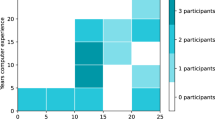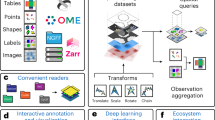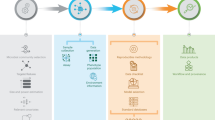Abstract
Logical models and physical specifications provide the foundation for storage, management and analysis of complex sets of data, and describe the relationships between measured data elements and metadata — the contextual descriptors that define the primary data. Here, we use imaging applications to illustrate the purpose of the various implementations of data specifications and the requirement for open, standardized, data formats to facilitate the sharing of critical digital data and metadata.
This is a preview of subscription content, access via your institution
Access options
Subscribe to this journal
Receive 12 print issues and online access
$209.00 per year
only $17.42 per issue
Buy this article
- Purchase on Springer Link
- Instant access to full article PDF
Prices may be subject to local taxes which are calculated during checkout

Similar content being viewed by others
References
Shyamsundar, R. et al. A DNA microarray survey of gene expression in normal human tissues. Genome Biol. 6, R22 (2005).
Janes, K. A. et al. The response of human epithelial cells to TNF involves an inducible autocrine cascade. Cell 124, 1225–1239 (2006).
Wouters, F. S., Verveer, P. J. & Bastiaens, P. I. Imaging biochemistry inside cells. Trends Cell Biol. 11, 203–211 (2001).
Andrews, P. D., Harper, I. S. & Swedlow, J. R. To 5D and beyond: Quantitative fluorescence microscopy in the postgenomic era. Traffic 3, 29–36 (2002).
Lippincott-Schwartz, J., Snapp, E. & Kenworthy, A. Studying protein dynamics in living cells. Nature Rev. Mol. Cell Biol. 2, 444–456 (2001).
Gerlich, D. & Ellenberg, J. 4D imaging to assay complex dynamics in live specimens. Nature Cell Biol. Suppl, S14–S19 (2003).
Neumann, B. et al. High-throughput RNAi screening by time-lapse imaging of live human cells. Nature Methods 3, 385–390 (2006).
Nybakken, K., Vokes, S. A., Lin, T. Y., McMahon, A. P. & Perrimon, N. A genome-wide RNA interference screen in Drosophila melanogaster cells for new components of the Hh signaling pathway. Nature Genet 37, 1323–1332 (2005).
Kittler, R. et al. An endoribonuclease-prepared siRNA screen in human cells identifies genes essential for cell division. Nature 432, 1036–1040 (2004).
Perlman, Z. E. et al. Multidimensional drug profiling by automated microscopy. Science 306, 1194–1198 (2004).
Ashburner, M. et al. Gene ontology: tool for the unification of biology. The Gene Ontology Consortium. Nature Genet 25, 25–29 (2000).
Hucka, M. et al. The systems biology markup language (SBML): a medium for representation and exchange of biochemical network models. Bioinformatics 19, 524–531 (2003).
Goldberg, I. G. et al. The open microscopy environment (OME) data model and XML file: open pools for informatics and quantitative analysis in biological imaging. Genome Biol. 6, R47 (2005).
Johnston, J., Nagaraja, A., Hochheiser, H. & Goldberg, I. A flexible framework for web interfaces to image databases: supporting user-gefined ontologies and links to external databases. 3rd IEEE Intl Symp. on Biomedical Imaging: Macro to Nano 1380–1383 (2006).
Thomann, D., Rines, D. R., Sorger, P. K. & Danuser, G. Automatic fluorescent tag detection in 3D with super-resolution: application to the analysis of chromosome movement. J. Microsc. 208, 49–64 (2002).
Ponti, A., Machacek, M., Gupton, S. L., Waterman-Storer, C. M. & Danuser, G. Two distinct actin networks drive the protrusion of migrating cells. Science 305, 1782–1786 (2004).
Dufour, A. et al. Segmenting and tracking fluorescent cells in dynamic 3-D microscopy with coupled active surfaces. IEEE Trans. Image Process 14, 1396–1410 (2005).
Platani, M., Goldberg, I., Lamond, A. I. & Swedlow, J. R. Cajal body dynamics and association with chromatin are ATP-dependent. Nature Cell Biol 4, 502–508 (2002).
Roques, E. J. S. & Murphy, R. F. Objective evaluation of differences in protein subcellular distribution. Traffic 3, 61–65 (2002).
Conrad, C. et al. Automatic identification of subcellular phenotypes on human cell arrays. Genome Res. 14, 1130–1136 (2004).
Chuai, M. et al. Cell movement during chick primitive streak formation. Dev. Biol. 296, 137–149 (2006).
Forouhar, A. S. et al. The embryonic vertebrate heart tube is a dynamic suction pump. Science 312, 751–753 (2006).
Seamer, L. C. et al. Proposed new data file standard for flow cytometry, version FCS 3.0. Cytometry 28, 118–122 (1997).
Brazma, A. et al. Minimum information about a microarray experiment (MIAME)-toward standards for microarray data. Nature Genet 29, 365–371 (2001).
Dowell, R. D., Jokerst, R. M., Day, A., Eddy, S. R. & Stein, L. The distributed annotation system. BMC Bioinformatics 2, 7 (2001).
Whetzel, P. L. et al. The MGED Ontology: a resource for semantics-based description of microarray experiments. Bioinformatics 22, 866–873 (2006).
Swedlow, J. R., Goldberg, I., Brauner, E. & Sorger, P. K. Informatics and quantitative analysis in biological imaging. Science 300, 100–102 (2003).
Huang, K., Lin, J., Gajnak, J. A. & Murphy, R. F. Image content-based retrieval and automated interpretation of fluorescence microscope images via the protein subcellular location image database. Proc. IEEE Symp. Biomed. Imaging 325–328 (2002).
Acknowledgements
Work in the authors' laboratories is supported by grants from the Wellcome Trust, the Biotechnology and Biological Sciences Research Council (BBSRC) and Cancer Research UK (J.R.S.) and the National Institutes of Health (I.G.G. and S.E.L.). J.R.S. is a Wellcome Trust Senior Research Fellow.
Author information
Authors and Affiliations
Ethics declarations
Competing interests
The authors declare no competing financial interests.
Rights and permissions
About this article
Cite this article
Swedlow, J., Lewis, S. & Goldberg, I. Modelling data across labs, genomes, space and time. Nat Cell Biol 8, 1190–1194 (2006). https://doi.org/10.1038/ncb1496
Issue Date:
DOI: https://doi.org/10.1038/ncb1496
This article is cited by
-
Rule-based knowledge aggregation for large-scale protein sequence analysis of influenza A viruses
BMC Bioinformatics (2008)
-
Dataset acquisition, accessibility, annotation, e-research technologies (DART) project
International Journal on Digital Libraries (2007)



